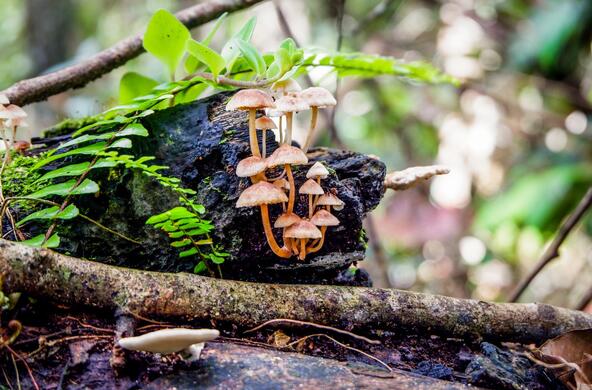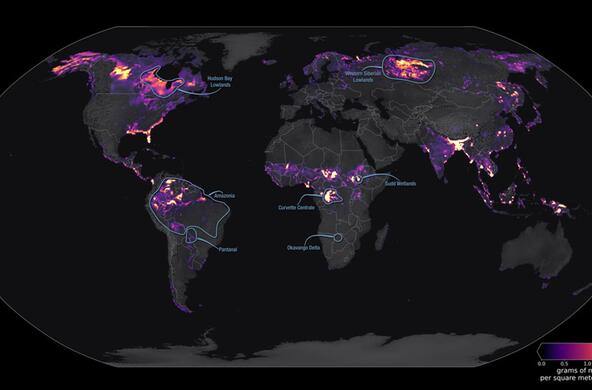Most plants respond to warm and cold temperatures. Give them a few warm days in spring and they will begin to grow. Give them a few cool days in autumn, and many will begin to turn colors, degrading their chlorophyll, which is green, in favor of other pigments, which can be yellow, red, or brown.
These are seasonal changes, but long-term conditions of temperature make a difference as well. The USDA recognizes “plant hardiness zones,” which show what will grow best in different regions of the country. In the desert Southwest, creosote bush is not found where the temperatures fall below -4 F (-20 C) on any night of the year. In the Northeast, sugar maple is not found north of an average wintertime temperature of -40 F (also -40 C).
So, with the ongoing warming of our climate, it makes sense that plants will respond. One might expect that many species might be found in more northerly locales, or higher on mountain slopes, in warmer conditions. Indeed, in Oregon, many plant species have already expanded in the hotter, drier slopes of the Siskiyou Mountains.
The pattern of change can be messy, and these natural history observations do not lead directly to a mechanistic understanding of what causes the changes in plant range. Changes in temperature are often accompanied by changes in soil moisture. Some plants cannot move unless essential root fungi also move under the same conditions. And, some plants cannot reproduce in new habitats if their pollinators are not present.
For forests, the response to higher temperatures is not immediate. A big, old tree can hang on for many years after its optimal conditions are lost, simply because it’s there, it’s well established, and it can shade the saplings of species that might be expected to outcompete it. Of course, in the face of windstorms, fire, lightning, and insect attacks, no tree lasts forever, and eventually even the giants of the forest will succumb. Attack by exotic insects can exacerbate the onset of change. With climate change, the new trees that replace them are likely to be different species, and eventually the entire forest composition may shift.
Ecologists question whether the dispersal of seeds from existing populations to new areas that become favorable habitat will be fast enough to keep up with climate change. The warming at the end of the last continental glaciation and the resulting changes in forest distribution provide some natural history data that pertain to dispersal rates.
Most forest species can disperse northward at rates of about 300 feet (0.1 km) per year. Trees with seeds dispersed by birds show some of the highest rates; seeds spread by wind fall close to home. Most projections of future climate indicate that dispersal rates in excess of 3000 feet (1.0 km) per year will be needed for trees to keep up. There will be winners and losers in the race to colonize new habitat. Those that fall behind are likely to be lost as a component of future forests and perhaps entirely.
The future distribution of trees is of more than passing interest to a few weekend naturalists. The forest-products industry should be deeply concerned about what is growing in forests today and what will be the optimal forest composition in the future. They are long-term investors in trees.
Unlike the father giving his naturalist son advice in the famous New Yorker cartoon of a few years ago, there may be big money for those who know about trees.
References
Arris, L.L. and P.S. Eagleson. 1989. Evidence of a physiological basis for the boreal-deciduous ecotone in North America. Vegetatio 82: 55-58.
Bose, A.K., A. Weiskittel, and R.G. Wagner. 2017. A three-decade assessment of climate-associated changes in forest composition across the northeastern USA. Journal of Applied Ecology doi: 10.1111/1365-2664.12917
Canham, C.D. and L. Murphy. 2017. The demography of tree species response to climate: sapling and canopy tree survival. Ecosphere 8: doi: 10.1002/ecs2/1701
Clark, J.S., M. Lewis, J.S. McLachlan, J. Hille Ris Lambers. 2003. Estimating population spread: what can we forecast and how well? Ecology 84:1979-1988.
Clark, J.S., A.E. Gelfand, C.W. Woodall, and K. Zhu. 2014. More than the sum of the parts: forest climate vulnerability from joint species distribution models, Ecological Applications, 24:990–999.
Clark, J.S., D.M. Bell, M.H. Hersh, and L. Nichols. 2011. Climate change vulnerability of forest biodiversity: climate and resource tracking of demographic rates. Global Change Biology, 17, 1834–1849.
Damschen, E.I., S. Harrison, and J.B. Grace. 2010. Climate change effects on an endemic-rich edaphic flora: resurveying Robert H. Whittaker’s Siskiyou sites (Oregon, USA). Ecology 91: 3609-3619
Dyderski, M.K., S. Paz, L.E. Frelich and A.M. Jagodzinski. 2017. How much does climate change threaten European forest tree species distributions? Global Change Biology doi: 10.1111/gcb/13925
González-Varo, J.P., J.V. López-Bao and J. Guitián. 2017. Seed dispersers help plants to escape global warming. Oikos 126: 1600-1606.
Pockman, W.T. and J.S. Sperry. 1997. Freezing-induced xylem cavitation and the northern limit of Larrea tridentata. Oecologia 109: 19-27.
Sakai, A., and C.J. Weiser. 1973. Freezing resistance of trees in North America with reference to tree regions. Ecology 54: 118-126.
Sittaro, F., A. Paquette, C. Messier, and C.A. Nock. 2017. Tree range expansion in eastern North America fails to keep pace with climate warming at northern range limits. Global Change Biology 23: 3292-3301.
Zhu, K, C. W. Woodall, S. Ghosh, A. E. Gelfand, J. S. Clark. 2014. Dual impacts of climate change: forestmigration and turnover through life history. Global Change Biology, 20:251-264.








